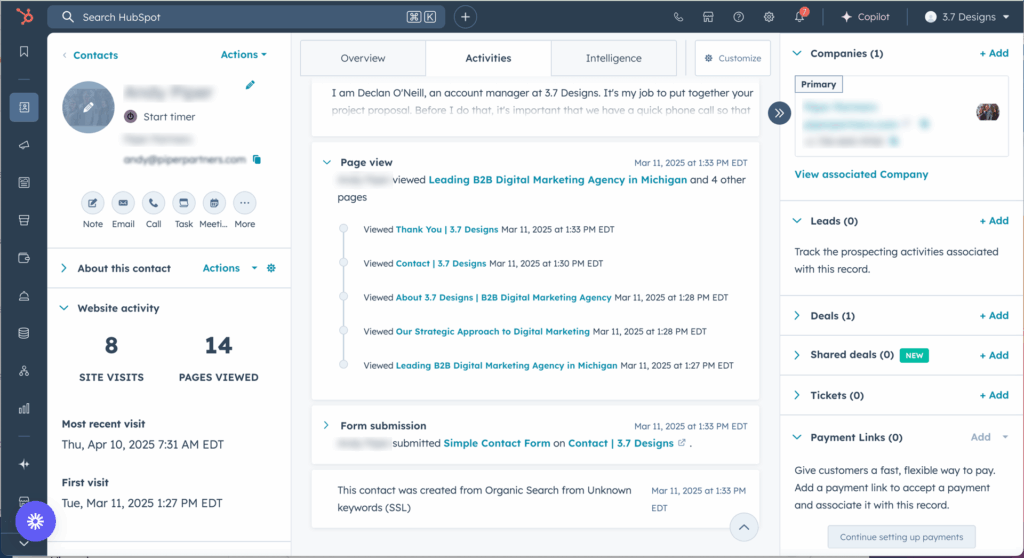- Digital Marketing
- Hubspot
- Published 07/10/2025
5 Real-World HubSpot CRM Use Cases That Actually Work for B2B Sales Teams

If you’re exploring HubSpot or just trying to figure out which tools your team actually needs, you’re in good company.
We talk to a lot of B2B marketers and sales leaders who are navigating long sales cycles, juggling multiple decision-makers, and trying to cut through the noise of endless options. It’s easy to feel overwhelmed.
So let’s be honest.
HubSpot isn’t a silver bullet. But in the right scenarios, it can be a powerful sales enablement and CRM platform that helps B2B teams close deals faster.
As a certified HubSpot Solutions Partner, we’ve seen the full range. Some clients thrive with it. Others find it wasn’t the tool they needed most. This article walks through five real-world HubSpot CRM use cases that help sales teams gain visibility, automate outreach, and engage decision-makers more effectively.
If you’re looking for clarity without pressure, this is for you.
Where HubSpot Fits In, And Where We Often Add Value
HubSpot can be extremely useful for organizing outreach, managing contacts, and automating follow-ups. It becomes even more helpful when marketing and sales teams need to collaborate on complex deals or long buying cycles.
But like any tool, it’s only as good as its setup. Many teams hit limits with reporting or find that automation doesn’t reflect how their real sales process works.
That’s where we often step in. We use Looker Studio to turn HubSpot’s data into clearer, full-funnel insights. For SEO, we pair HubSpot with competitive tools like SEMrush to drive stronger content strategy. And when it comes to configuring the platform, we focus on aligning it to your actual workflows — not a generic best-practice template.
1. You Know Who You Want to Reach, But They Aren’t Engaging
Imagine having a list of dream clients saved in a spreadsheet. Maybe you’ve reached out a few times, but it’s hard to tell if they’re even aware of your brand.
HubSpot makes this easier to manage. You can tag those companies as target accounts, track their visits to your website, and get notified when someone from their team takes action. With this visibility, outreach becomes more focused and less of a guessing game.
With this visibility, outreach becomes more focused and less of a guessing game. You can view a contact’s activity feed, including which pages they visited, what forms they filled out, and whether they viewed key content like pricing or case studies.

2. You Sell to More Than One Person at a Time
In complex B2B sales, you’re rarely dealing with just one buyer. You might have a user who loves your solution, a manager concerned with ROI, and a compliance officer making sure it clears all the internal checks.
HubSpot helps you group everyone from the same company into a single view. You can track their roles, tailor your messaging to what matters to them, and see how the entire team is engaging across touchpoints. Instead of sending the same email to everyone, your outreach speaks directly to their part in the process.
Using custom properties, you can segment contacts by role or buying influence, then tailor workflows or sequences to speak directly to each persona. For example, a technical evaluator might receive a different follow-up than a financial decision-maker, while all activity is tracked under the same company record.
3. You Have a Long Sales Cycle and Timing is Tricky
If you sell to hospitals, universities, or other large organizations, it’s not unusual for opportunities to go quiet for weeks or months. It’s hard to know when to check back in.
HubSpot helps by showing when interest starts to resurface. For example, if someone downloads a resource after a long pause, that can be your signal to reach out. You can also set up light-touch check-ins that stay helpful and relevant, rather than overwhelming.
You can also use HubSpot’s Deals pipeline to automatically track average time to close, identify bottlenecks in the process, and optimize how you engage contacts at each stage. Combined with lead nurturing workflows, this helps your team stay top of mind without overcommitting reps.
4. You’re Navigating Complicated Internal Buy-In
In enterprise sales, you might talk to five different teams before anything moves forward. One team likes what you offer, but another hasn’t even heard of you.
With HubSpot, your team can track all engagement at the company level. You’ll know who’s opened what, what’s been shared internally, and where things may be stuck. That insight can help move conversations forward more strategically and avoid repeating yourself.
5. You Want to Grow Existing Accounts, Not Just Land New Ones
Sometimes your first deal is only the beginning. Maybe you’ve signed on one region or department, but there’s potential to expand across other teams or locations.
HubSpot helps you spot those opportunities. You can track engagement trends, identify which contacts are interacting with emails, content, or landing pages, and trigger timely follow-ups based on behavior, all tied to the same company record.
If you’re using WordPress, we often integrate HubSpot tracking across your site to capture key behavioral signals. That way, you’ll know when interest is growing in a different service line or region, and customer success becomes part of your growth strategy, not just a support function.
When HubSpot Isn’t the Best Fit
If your sales process is short and straightforward, or you’re not ready to invest in a CRM system, there are lighter tools that might make more sense for now.
But if you’re managing a longer journey with multiple contacts and a lot of moving parts, HubSpot can help keep everything connected. It works best when it’s customized to fit the way your team already works — not the other way around.
Final Thought: HubSpot Only Works When the Strategy Does
Most teams don’t need more platforms. They need a system that gives them clarity.
That might mean seeing which accounts are engaged, understanding what’s working, or creating content that speaks to different decision-makers. HubSpot can support all of that, but it has to be part of something bigger.
We help companies use HubSpot effectively by making sure it’s aligned to strategy from the start. If you’re building a more connected system and want a partner who’s been there, we’d be happy to help you think it through.
No pressure. Just perspective and a clearer path forward.